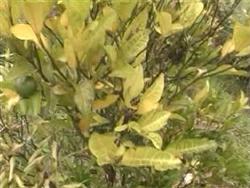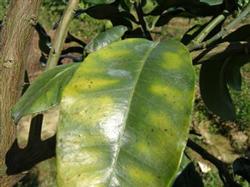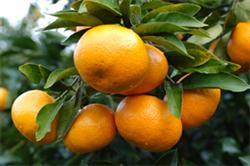Introduction and control of citrus planthopper

Citrus psyllid [Diaphorinacitri kuwayama] belongs to Homoptera, Psyllidae. It is an important pest in citrus tender shoot stage, mainly damaging citrus, but also damaging Rutaceae plants such as Murraya paniculata and yellow bark. Characteristics of damage: adults and nymph swarm on tender shoots, young leaves and new buds to suck juice damage. Injured young shoots shriveled and withered, new leaves deformed and twisted. More importantly, the insect has been proved to be the vector of citrus yellow dragon disease, so doing a good job in the control of citrus psyllid is not only to reduce the need of insects to damage citrus, but also to comprehensively control citrus yellow dragon disease to control the spread of the disease. The adult is a small insect with a body length of about 3 mm. All green gray, translucent wings with brown stripes, body covered with white wax powder, head sharp process, after the chest is wider, the whole insect nearly rhombic. Nymph flat oval, yellow body, a total of 5 instars, wing buds, each instar nymph abdominal secretion of short white wax filaments. Habit: The insect can produce 8~14 generations a year. In citrus orchards of Guangdong, Guangxi, Fujian and Taiwan, it can be seen in various stages all year round. It overwinters with dense adults on the back of leaves. It begins to lay eggs on spring shoots in late February of the next year. The generations overlap in the middle of the year. The population dynamics of citrus psyllid was consistent with the growth period of citrus shoots. In South China, there are three peaks in the middle of the year, which occur from the middle of March to April, from late May to late June and from July to August and September respectively, that is, the main development periods of citrus shoots in spring, summer and autumn. Generally, the number of insects on autumn shoots is the most, and the damage is the most serious, causing autumn buds to die. In different citrus orchards, due to different nutritional and reproductive conditions, the number of psyllid occurrence is also inconsistent. Food, climate, cultivation, pesticide application and natural enemy activity are the factors affecting population density of psyllid, among which food is the most important factor. Long-term overcast rain is unfavorable to the reproduction of psyllid, and the number of insects decreases obviously. Usually, the insect population density of weak trees and Huanglong infected trees is much higher than that of healthy trees, and the difference can be as high as 10 times to dozens of times. This is because the branches and leaves of weak trees and infected trees are sparse and the tips are not neat, which is conducive to the spawning and reproduction of psyllids. Citrus psyllid was mainly distributed in aggregated core, adults had weak flight ability, migration and diffusion were slow, and nymph activity was weaker. Adults tend to yellow and red. According to these characteristics, we should strengthen the general survey of insect situation in prevention and control. Once the insect source center is found, spraying pesticide in time can treat the insect control effect. The natural enemies of citrus psyllid include jumping wasps, ladybugs, lacewings, flower bugs, thrips, mantis, aphids, mites, spiders and ants. The parasitism rate of the nymph and pupa was as high as 30%~50%, which had certain inhibition effect on psyllid and should be protected and utilized. Control methods: The following links should be grasped in the control of citrus psyllid: 1. Agricultural control: ① Do a good job in the rules of orange orchard and avoid planting multiple varieties of flowers. (2) Cut down Huanglong diseased trees and weak trees that have lost their ability to bear fruit in time to reduce the source of insects. (3) Strengthen crown management, make branches grow neatly, and deteriorate insect spawning and breeding sites. 2. Ecological control: It is mainly to create shelterbelts and create environmental conditions that are not conducive to the reproduction and spread of psyllids. In gardens without shelterbelt, high stalk green manure should be planted at least at the edge of the garden and between rows to hinder the migration and spread of psyllid, which can inhibit insects and prevent diseases. 3, timely spraying protection of new shoots: should be on the basis of the occurrence period and occurrence of insects forecast, in each time the new shoots sprout about 5 cm long timely spraying. 95% chlorfenuron 1 000 times solution, or 20% fenvalerate 3 000 times solution, or 2.5% dichlormethrin 1 000~1 500 times solution, or 50% dichlorvos 1 000 times solution, or 44% polychlorphenamine 1 500 times solution, or 10% dichlorvos cypermethrin 4 000 times solution, or 2.5% rotenone 500 times solution.
- Prev

Prevention and treatment of magnesium deficiency in Citrus
In recent years, due to the transfer of a large number of rural labor force to cities and towns, the amount of livestock raised by farmers is decreasing, and the source of organic fertilizer is significantly reduced. Coupled with the depressed fruit prices for many years, the amount of organic fertilizer used by fruit farmers in fruit production has been greatly reduced, or even not used. As a result, the phenomenon of element deficiency in orchards has been increasing in recent years. Especially the medium element magnesium.
- Next

Citrus fruits are rich in more than 30 nutrients.
At present, there are more than 30 kinds of human health substances in citrus fruits, including flavonoids, monoterpenes, coumarins, carotenoids, propanols, acridone, glycerol lipids and so on. Flavonoids there are three types of flavonoids in citrus fruits: ⅰ is represented by rutin.
Related
- Moge, come on! The staff of the peasant association in the producing area of cantaloupe were frightened when the crowd gathered.
- Causes and Solutions of low Fruit setting rate of Apple
- Symptoms and control measures of passion fruit virus disease
- Fruit growing lesson: how do apple orchards keep high yields?
- Can you build orchards in the mountains? What are the pros and cons?
- How to manage the coloring period of Crisson grape?
- This paper introduces the processing technology of two kinds of fig products.
- How much is a month for retired teachers in rural areas by 2020?
- How can strawberry planting increase sugar content? We should pay attention to management in many aspects.
- What are the cultivation techniques on how to improve the yield of golden fruit?

